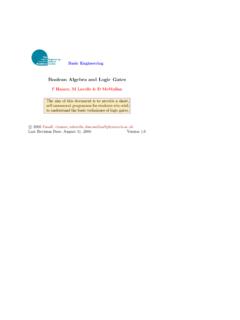Transcription of Signals, Systems and Inference, Chapter 11: Wiener Filtering
1 CHAPTE R 11 Wiener Filtering INTRODUCTION In this Chapter we will consider the use of LTI Systems in order to perform minimum mean-square-error (MMSE) estimation of a WSS random process of interest, given measurements of another related process. The measurements are applied to the input of the LTI system, and the system is designed to produce as its output the MMSE estimate of the process of interest. We first develop the results in discrete time, and for convenience assume (unless otherwise stated) that the processes we deal with are zero-mean.
2 We will then show that exactly analogous results apply in continuous time, although their derivation is slightly different in certain parts. Our problem in the DT case may be stated in terms of Figure Here x[n] is a WSS random process that we have measurements of. We want to determine the unit sample response or frequency response of the above LTI system such that the filter output yb[n] is the minimum-mean-square-error (MMSE) estimate of some target process y[n] that is jointly WSS with x[n]. Defining the error e[n] as e[n] = yb[n] y[n] , ( ) we wish to carry out the following minimization: min = E{e 2[n]}.
3 ( ) h[] The resulting filter h[n] is called the Wiener filter for estimation of y[n] from x[n]. In some contexts it is appropriate or convenient to restrict the filter to be an FIR (finite-duration impulse response) filter of length N, h[n] = 0 except in the interval 0 n N 1. In other contexts the filter impulse response can be of infinite duration and may either be restricted to be causal or allowed to be noncausal. In the next section we discuss the FIR and general noncausal IIR x[n] LTI h[n] yb[n] = estimate y[n] = target process FIGURE DT LTI filter for linear MMSE estimation.
4 C Alan V. Oppenheim and George C. Verghese, 2010 195 X ! |{z} bb196 Chapter 11 Wiener Filtering (infinite-duration impulse response) cases. A later section deals with the more involved case where the filter is IIR but restricted to be causal. If x[n] = y[n]+v[n] where y[n] is a signal and v[n] is noise (both random processes), then the above estimation problem is called a Filtering problem. If y[n] = x[n + n0] with n0 positive, and if h[n] is restricted to be causal, then we have a prediction problem. Both fit within the same general framework, but the solution under the restriction that h[n] be causal is more subtle.
5 NONCAUSAL DT Wiener FILTER To determine the optimal choice for h[n] in ( ), we first expand the error criterion in ( ): = E + X k =h[k]x[n k] y[n] !2 . ( ) The impulse response values that minimize can then be obtained by setting = 0 for all values of m for which h[m] is not restricted to be zero (or h[m] otherwise pre-specified): h[m] = E 2 h[k]x[n k] y[n] x[n m] k e[n] = 0 . ( ) The above equation implies that E{e[n]x[n m]} = 0, or Rex[m] = 0, for all m for which h[m] can be freely chosen.
6 ( ) You may recognize the above equation (or constraint) on the relation between the input and the error as the familiar orthogonality principle: for the optimal filter, the error is orthogonal to all the data that is used to form the estimate. Under our assumption of zero-mean x[n], orthogonality is equivalent to uncorrelatedness. As we will show shortly, the orthogonality principle also applies in continuous time. Note that Rex[m] = E{e[n]x[n m]} = E{(yb[n] y[n])x[n m]} = R[m] Ryx[m] . yx( ) Therefore, an alternative way of stating the orthogonality principle ( ) is that Ryx[m] = Ryx[m] for all appropriate m.
7 ( ) c Alan V. Oppenheim and George C. Verghese, 2010 bSection Noncausal DT Wiener Filter 197 In other words, for the optimal system, the cross-correlation between the input and output of the estimator equals the cross-correlation between the input and target output. To actually find the impulse response values, observe that since yb[n] is obtained by Filtering x[n] through an LTI system with impulse response h[n], the following relationship applies: Ryx[m] = h[m] Rxx[m] . ( ) Combining this with the alternative statement of the orthogonality condition, we can write h[m] Rxx[m] = Ryx[m] , ( ) or equivalently, X h[k]Rxx[m k] = Ryx[m] ( ) k Equation ( ) represents a set of linear equations to be solved for the impulse response values.
8 If the filter is FIR of length N, then there are N equations in the N unrestricted values of h[n]. For instance, suppose that h[n] is restricted to be zero except for n [0, N 1]. The condition ( ) then yields as many equations as unknowns, which can be arranged in the following matrix form, which you may recognize as the appropriate form of the normal equations for LMMSE estimation, which we introduced in Chapter 8: Rxx[0] Rxx[ 1] Rxx[1 N] h[0] Ryx[0] Rxx[1] Rxx[0] Rxx[2 N] h[1] = Ryx[1] .. Rxx[N 1] Rxx[N 2] Rxx[0] h[N 1] Ryx[N 1] ( ) These equations can now be solved for the impulse response values.
9 Because of the particular structure of these equations, there are efficient methods for solving for the unknown parameters, but further discussion of these methods is beyond the scope of our course. In the case of an IIR filter, equation ( ) must hold for an infinite number of values of m and, therefore, cannot simply be solved by the methods used for a finite number of linear equations. However, if h[n] is not restricted to be causal or FIR, the equation ( ) must hold for all values of m from to + , so the z-transform can be applied to equation ( ) to obtain H(z)Sxx(z) = Syx(z) ( ) The optimal transfer function, the transfer function of the resulting ( Wiener ) filter, is then H(z) = Syx(z)/Sxx(z) ( ) If either of the correlation functions involved in this calculation does not possess a z-transform but if both possess Fourier transforms, then the calculation can be carried out in the Fourier transform domain.
10 Alan V. Oppenheim and George C. Verghese, 2010 cbb198 Chapter 11 Wiener Filtering Note the similarity between the above expression for the optimal filter and the expression we obtained in Chapters 5 and 7 for the gain Y X / XX that multiplies a zero-mean random variable X to produce the LMMSE estimator for a zero-mean random variables Y . In effect, by going to the transform domain or frequency domain, we have decoupled the design into a problem that at each frequency is as simple as the one we solved in the earlier chapters. As we will see shortly, in continuous time the results are exactly the same: Ryx( ) = Ryx( ), ( ) h( ) Rxx( ) = Ryx( ), ( ) H(s)Sxx(s) = Syx(s), and ( ) H(s) = Syx(s)/Sxx(s) ( ) The mean-square-error corresponding to the optimum filter, the minimum MSE, can be determined by straightforward computation.















